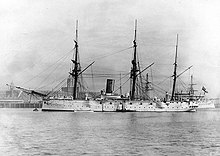Sailing steamer

A sailing steamer is a steamship with additional sails . These ships were widespread in the second half of the 19th century and into the 20th century as cargo , passenger and warships . Most of these ships were equipped with two or three masts. They had the one riggings similar to those of sailing ships as brig , brigantine , Gaffelschoner (two or three masts), Bark , Barkentine or full-rigged ship , but also special rigs, other than a frame- or Schrat rigged sailing ship.
Well-known representatives were those
- Great Western from 1837 (wooden hull, paddle wheel drive, four masts with schooner rigging),
- Great Britain from 1845 (screw drive, 6 masts with sloping sails, 2nd mast with yards)
- and the sailing screw paddle steamer Great Eastern from 1858 with six masts (2nd / 3rd mast square sail , otherwise slanting sail ) with a sail area of 5,450 m².
The large German auxiliary sailor , the five-masted barque RC Rickmers , was sometimes referred to as a sailing steamer because it had a relatively large steam engine .
The test ship Civetta with Josef Ressel's propeller was built in Trieste from 1827 to 1829 , financed by Fontana , and tested there in the port in 1829; it had a 4.4 kW steam engine in addition to two-masted sails.
